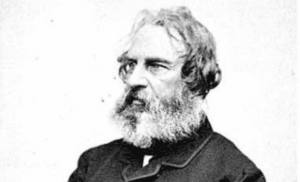We’re excited to welcome back Wheaton College professor Leland Ryken as our literature scholar in residence to guide us in reading together the classic Nathaniel Hawthorne short story “Young Goodman Brown.” This week he introduces the work and describes the literary conventions and context. Next week, after you’ve read the story, he’ll prompt discussion of the style and substance of this enduring classic.
Previously in Commending the Classics:
- Piper, Ryken, Reynolds, and Nielson Commend the Classics
- 10 Essential Classics of Western Literature
- Why Christians Should Read Camus
Nathaniel Hawthorne’s short story “Young Goodman Brown” is a classic of American fiction. It was published anonymously in New England magazine in 1835, and later reprinted under Hawthorne’s name in his short story collection Mosses from an Old Manse (1846).
The world portrayed within the story is the same 17th-century Puritan New England world that Hawthorne later evoked in The Scarlet Letter. Specifically, this story is set in “Salem village” (as the opening sentence quaintly labels it). The entire frame of reference within the story is Puritan, with references to minister, deacon, Sabbath day, catechism, sin, and such things.
While it is possible to situate the story within Hawthorne’s religious beliefs, the story does not require that we contextualize in it this way. The issues raised by the story are universal, and the religious milieu within the world of the story is merely the vehicle for embodying those issues.
As with most of Hawthorne’s fiction, this story has been extravagantly debated, over-interpreted, and misinterpreted. The story poses the problem of the gap between outward piety and respectability and the presence of hidden sin. The protagonist of the story confronts this gap for the first time and is destroyed by his newfound knowledge. The story implicitly offers this as an example of how not to cope with the knowledge of hidden sinfulness, leaving it to the reader to find a better alternative.
While the application of these issues takes on a certain urgency for Christians, the issues themselves are universal. Everyone faces the need to make sense of the hypocrisy represented by outwardly good people who harbor hidden sin. The story cannot be taken as an attack on Christians or the Christian faith. It is an attack on everyone’s hypocrisy.
Plot summary: The protagonist of the story, Young Goodman Brown, feels a compulsion to set off at sunset from a street of Salem village into the forest on an urgent but unexplained nighttime journey. Only three months married, he bids farewell to his wife, Faith, and proceeds into the forest. As he travels, he encounters a character whose traits allow us to identify him as Satan. Then Young Goodman Brown encounters leaders of the local church and town. While the first people encountered by the protagonist are public examples of piety and morality, once Young Goodman Brown arrives in the middle of the forest it turns out that the whole community is there, “both pious and ungodly.” Even Faith is present. The main event in the sinister forest is a demonic communion service with the usual ingredients of a Sunday church service. A demonic figure oversees the service and imparts instruction regarding the evil of the human race. The next morning, Young Goodman Brown returns to village a totally embittered outcast.
Literary Genres and Conventions
Before we explore what Hawthorne intends with this action, we need to get a firm grip on certain literary conventions that form the basis of the story and our interpretation of it. Without this awareness, it is easy to misinterpret certain aspects of what Hawthorne is saying.
We can start with the protagonist, whose very name establishes him as Everyman—-a representative figure of the human race. Goodman was a commonplace honorific title, equivalent to our “Mr.” Young establishes the youthfulness of the protagonist. This is important to the story, because he is initiated into something for the first time. Brown is a prosaic, commonplace name, perhaps also hinting at the protagonist’s affinities with the darkness of the forest.
A second genre that exerts a continuous presence is fantasy. The story whisks us away to a world of the imagination. The word surreal is also appropriate, in the dual sense of (1) eerie, distorted, unnatural, and (2) something projected from the subconscious or inner being. At the level of storytelling, Hawthorne’s inventiveness in creating a vivid fantasy world (skill at worldmaking, literary critics call this ability) is part of the entertainment aspect of the story.
Crucial to the meaning of the story is the literary genre known as the dream vision. Storytellers and poets use the dream vision framework in two situations—-when portraying supernatural reality that transcends waking reality around us, and when portraying wish-fulfillment experiences (so that a love poet might picture winning the affection of the beloved—-or even the sheer perfection of the beloved—-as a dream). Late in Hawthorne’s story, the question arises as to whether Young Goodman Brown might have “fallen asleep in the forest and only dreamed a wild dream of a witch meeting.” Whether the journey was real (within the premise of a fantasy story) or packaged as a conventional dream vision, the reality of the evil thus pictured is not a figment of the protagonist’s imagination.
This story is also a triumph of parody, an imitation of an established form with inverted effect. In this story, numerous details of the service in the forest are a demonic version of what transpires in a Christian church service. Hawthorne’s cleverness in working this out systematically should be duly relished.
Finally, symbolism and allegory are fully operative in this story. Both techniques depend on the premise of double meaning: something with a literal identity in the story also stands for something else. The forest is the archetypal sinister forest of the fantastic imagination, and it simultaneously embodies evil. The journey into this sinister forest is both a physical journey and a spiritual and psychological journey of the soul and mind. The congregation that assembles in the forest symbolizes the whole human race. And so forth.
All of the foregoing genres and techniques make this story a triumph of the imagination. The story raises a central problem of living, and it does so in a somewhat didactic and moralizing manner at some points. But we must resist an immediate impulse to treat the story like a religious discourse or sermon. First we need to relish the literary qualities of the story.
Assimilate this story by observing its progressive element. Hawthorne begins by establishing the mysterious journey of Young Goodman Brown as a kind of riddle, and then he subtly doles out more and more information, allowing us gradually to solve the riddle of the mysterious journey.

































